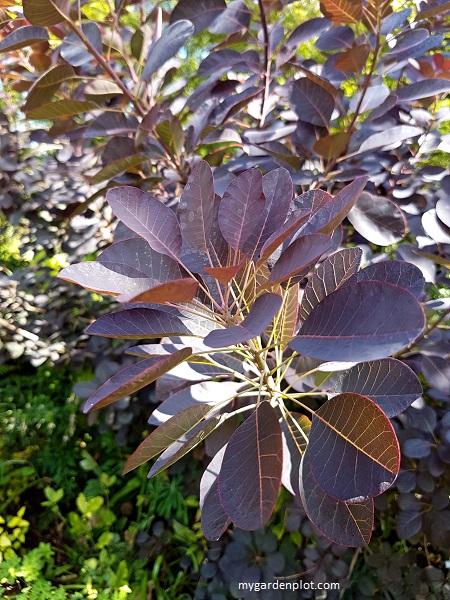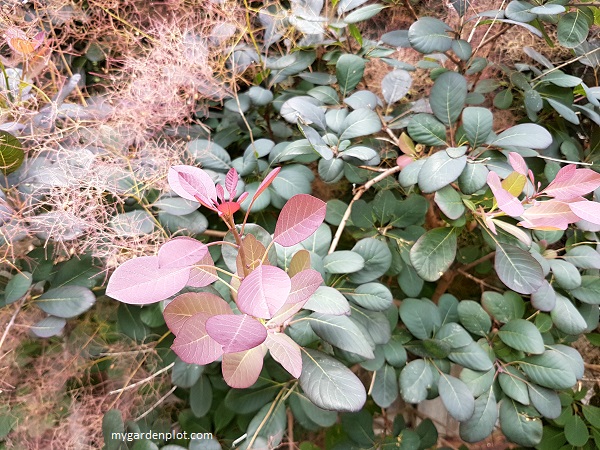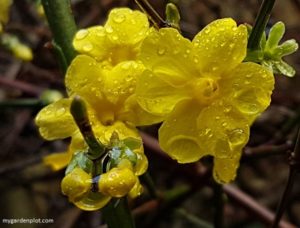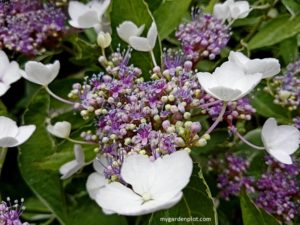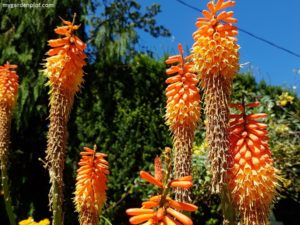How to Plant, Care and Prune Cotinus coggygria, commonly known as Smoketree, Smoke Bush Or Wig Tree
The Cotinus coggygria Smoketree (or Smoke Tree) is really a shrub, not a tree. It is also commonly referred to as Smoke Bush or Wig Tree. It is a deciduous shrub that can get as tall as 6 metres (20 feet). Its natural habit is round and bushy.
Suitable for any garden size, the smoketree is easy to prune and maintain to a manageable size either as a dwarf shrubby plant, kept as a medium-sized shrub or train as a small tree with a single stem. Growing and pruning the smoketree to look like a tree is popular with gardeners.
The smoketree or smoke bush names come from the textural smoky appearance of puffy clouds made of a cluster of tiny flowers emerging early summer. These puffs of flower ‘smoke’ adorn the tree through to late summer. It is an attractive shrub (or tree) that is easy to grow and care for. It thrives in full sun (6+ hours daily) for vibrant foliage. It can tolerate partial shade but may reduce colour intensity.
The hardy smoketree grows in zones 4 to 9.
As an accent deciduous plant with changing foliage colour, it looks very attractive in a mixed summer garden border with evergreens. The foliage from spring to fall changes colours adding contrast and interest. It especially looks beautiful with a pink or purple clematis vine flowering through it. The purple-green foliage with plum-shaped leaves turn red, orange and purple in autumn (fall).
It can also be used with container gardening. Its roots adapt to the container restrictions, similar to the weeping Japanese maple tree, and looks fabulous in a large ceramic pot.
The smoketree is native to North America, southern Europe and Asia. Though not listed as poisonous, contact with sensitive skin may cause dermatitis.
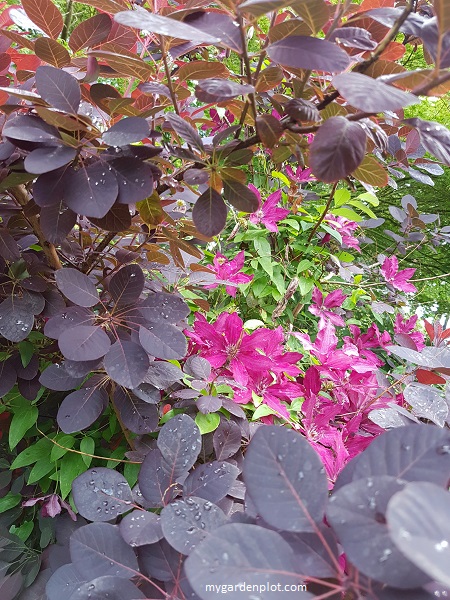
Smoketree / Smoke Bush At A Glance
Type: Deciduous Shrub (or tree)
Location: Full to Part Sun (partial shade may reduce colour intensity)
Blooming Season: Summer
Size: 3 – 6 metres (10 – 20 feet) tall and 3 – 4.5 metres (10 – 15 feet) spread
When To Prune: If required, late winter or early spring (see pruning notes below)
Plant Hardiness Zones: 4 – 9
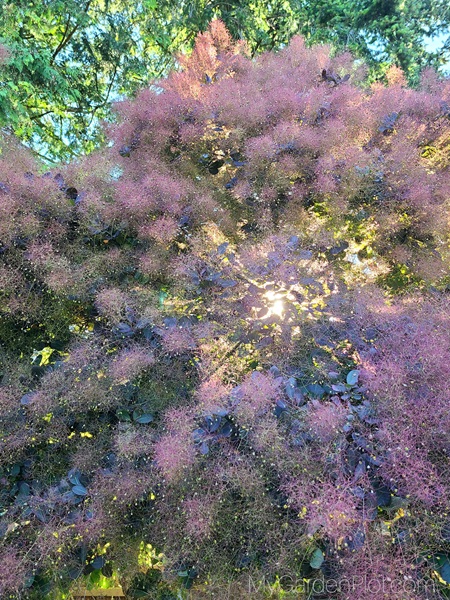
Where To Plant And How To Grow Smoketree / Smoke Bush
The smoketree or smoke bush is a low maintenance shrub which thrives in a sunny or part sunny site. Purple varieties fade in shade. Plant in spring or fall to avoid extreme temperatures. Allow 10 to 15 feet between plants to accommodate mature size for varieties that grow 10 to 15 feet tall/wide.
It tolerates most soil types but grows best in well-drained, fertile, humus-rich soil that is moist. Avoid waterlogged areas. Prefers slightly acidic to neutral pH (6.0-7.0). Due to this versatility, smoketrees can be planted in rocky coastal soils and is adaptable to poor sandy soil types. So long at the location is free-draining and with sun, the smoketree will do well.
For poor soil conditions, add rich organic compost every spring or top-dress with a mix of slow-release balanced fertilizer (10-10-10). Avoid over-fertilizing, which can reduce flowering.
For the first growing season water deeply 2 to 3 times weekly to establish roots. Once established, the smoke bush is drought tolerant. Water moderately during prolonged dry spells. Avoid overwatering to prevent root rot. Yellow leaves may indicate overwatering.
For winter care, apply mulch around the base to insulate roots in colder zones 4 to 7 in the Pacific Northwest. Young plants may need burlap wraps in harsh winters.
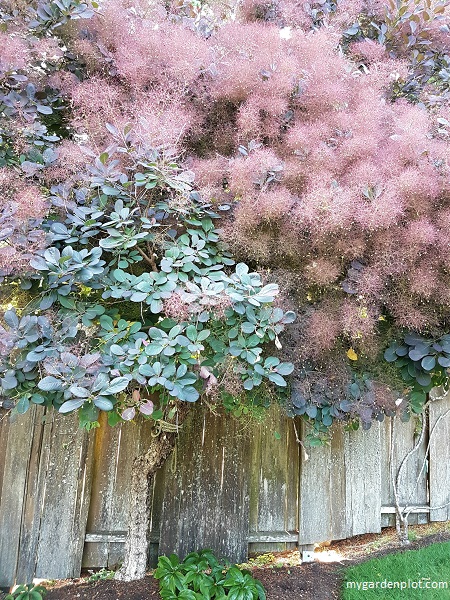
RELATED TOPIC: Buyer’s Guide On How To Choose Hand Pruners (Secateurs)
When and How to Prune a Smoketree / Smoke Bush
If allowing the smoketree to grow into its natural habit, little pruning is necessary annually. With the exception, of course, of removing any deadwood or damaged stems. Any routine pruning to remove straggly or overcrowding should also be done late winter or early spring before new growth. Cutting back 6 to 12 inches can encourage large, colourful leaves but will reduce flowering.
To fix leggy growth with a new plant, prune to encourage bushiness.
For an established smoke bush in the Pacific Northwest it is recommended to thin for airflow to prevent powdery mildew.
It is best to keep remedial pruning for mature smoketrees be done over two years rather than in one session.
It grows moderately fast, and if you wish to contain the smoketree as a low shrub, it can be cut right back to the ground in early spring.
The smoketree responds to hard pruning with larger leaves and a renewed vigour for foliage effect if this is the primary interest. However, to flower well, less pruning is recommended.
To encourage the Smoke bush to grow as “tree” form, select a central leader and prune lower branches.
Tools Needed For Pruning Smoketree / Smoke Bush
Below is the list of essential tools needed to prune a smoke tree:
- Pruners
- Long-handled Loppers
- Pruning Saw
- Garden Gloves
RELATED TOPIC: Buyer’s Guide On How To Choose A Pruning Saw
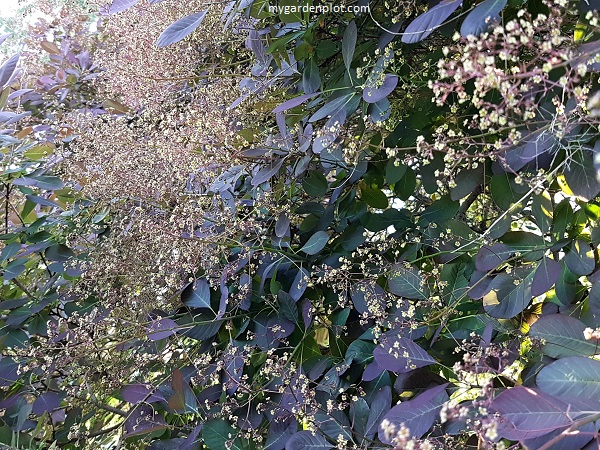
Plant Recommendations
Smoke trees add striking texture and color to landscapes with minimal care, making them ideal for low-maintenance gardens. Choose cultivars based on desired foliage and garden space.
Popular Cotinus coggygria and cultivars include the ‘Royal Purple’ or ‘Purple Smoketree’ for its dark purple foliage that turns red in autumn. While the C. ‘Grace’ hybrid is outstanding with purple-red leaves and red plumes. Both need full sun for colour.
The attractive and refreshing C. ‘Golden Spirit’ with its chartreuse foliage of lime green, tolerates partial shade locations.
The C. ‘Flame’ is a smaller bushy shrub with purple-pink flower clusters and leaves that give a fiery display of reds and oranges in autumn.
Pests And Diseases
The smoketree is generally trouble-free and pest-resistant; occasional aphids can be hosed off. It is generally deer resistant but may be nibbled by young curious deer.
Occasionally the smoketree can be affected by powdery mildew which can be improved with better airflow by pruning. Verticillium wilt (wilting/yellowing) in the Pacific Northwest can cause wilting and yellowing and can be avoided by planting in well-draining soil. Improve soil and remove affected branches.
The most important concern should be that it should not be planted in very wet soils that could cause root rot. To ensure this does not happen, ensure good drainage when planting.
Propagating Smoketree / Smoke Bush
Smoketree cuttings can be taken early to mid-summer. Use rooting hormone for better success. Also try layering to produce a new plant. Bend a low-growing branch to soil level, and cover with soil to encourage rooting. Once rooted, cut from its parent for your new smoke bush.
